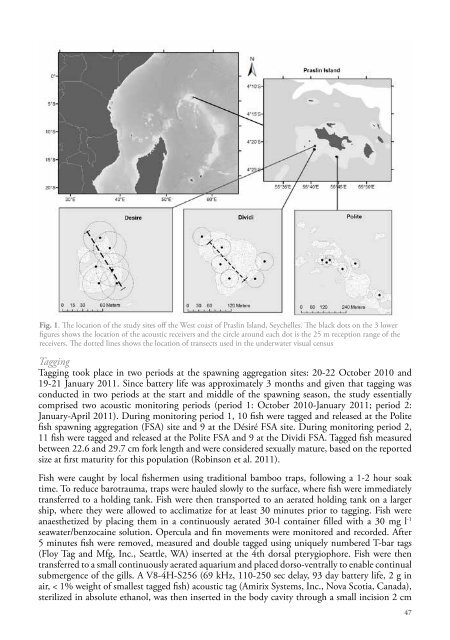WIOMSA-CORDIO spawning book Full Doc 10 oct 13.pdf
WIOMSA-CORDIO spawning book Full Doc 10 oct 13.pdf
WIOMSA-CORDIO spawning book Full Doc 10 oct 13.pdf
Create successful ePaper yourself
Turn your PDF publications into a flip-book with our unique Google optimized e-Paper software.
Fig. 1. The location of the study sites off the West coast of Praslin Island, Seychelles. The black dots on the 3 lowerfigures shows the location of the acoustic receivers and the circle around each dot is the 25 m reception range of thereceivers. The dotted lines shows the location of transects used in the underwater visual censusTaggingTagging took place in two periods at the <strong>spawning</strong> aggregation sites: 20-22 October 20<strong>10</strong> and19-21 January 2011. Since battery life was approximately 3 months and given that tagging wasconducted in two periods at the start and middle of the <strong>spawning</strong> season, the study essentiallycomprised two acoustic monitoring periods (period 1: October 20<strong>10</strong>-January 2011; period 2:January-April 2011). During monitoring period 1, <strong>10</strong> fish were tagged and released at the Politefish <strong>spawning</strong> aggregation (FSA) site and 9 at the Désiré FSA site. During monitoring period 2,11 fish were tagged and released at the Polite FSA and 9 at the Dividi FSA. Tagged fish measuredbetween 22.6 and 29.7 cm fork length and were considered sexually mature, based on the reportedsize at first maturity for this population (Robinson et al. 2011).Fish were caught by local fishermen using traditional bamboo traps, following a 1-2 hour soaktime. To reduce barotrauma, traps were hauled slowly to the surface, where fish were immediatelytransferred to a holding tank. Fish were then transported to an aerated holding tank on a largership, where they were allowed to acclimatize for at least 30 minutes prior to tagging. Fish wereanaesthetized by placing them in a continuously aerated 30-l container filled with a 30 mg l -1seawater/benzocaine solution. Opercula and fin movements were monitored and recorded. After5 minutes fish were removed, measured and double tagged using uniquely numbered T-bar tags(Floy Tag and Mfg, Inc., Seattle, WA) inserted at the 4th dorsal pterygiophore. Fish were thentransferred to a small continuously aerated aquarium and placed dorso-ventrally to enable continualsubmergence of the gills. A V8-4H-S256 (69 kHz, 1<strong>10</strong>-250 sec delay, 93 day battery life, 2 g inair, < 1% weight of smallest tagged fish) acoustic tag (Amirix Systems, Inc., Nova Scotia, Canada),sterilized in absolute ethanol, was then inserted in the body cavity through a small incision 2 cm47


















